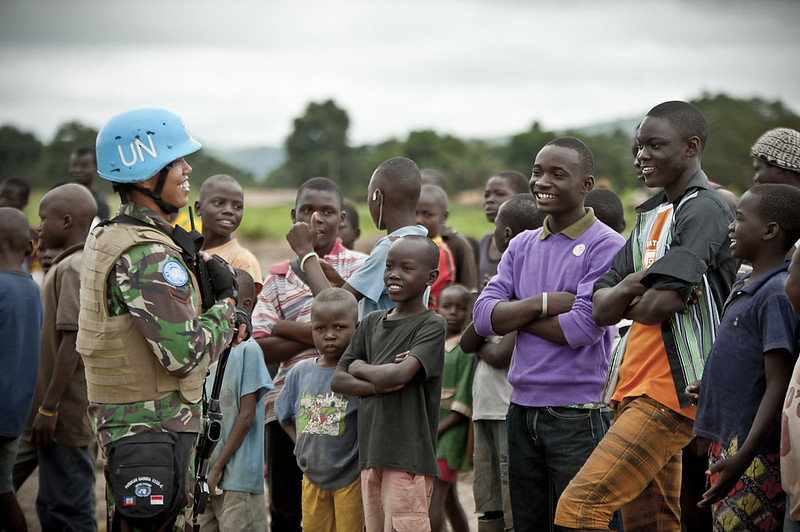Since the initial Protection of Civilians (POC) resolutions in 1999 (Res. 1265 and Res. 1270), which framed operations of the UN Assistance Mission in Sierra Leone (UNAMSIL), our role in protecting civilians has grown significantly. It is now an essential duty for more than 95 per cent of our currently deployed UN peacekeepers.
Often deployed where civilian populations are most at risk, UN peacekeepers protect those most vulnerable in conflict including those displaced and fleeing their homes or under threat due to their religion, age, ethnicity or gender. Peacekeepers implement this important task in increasingly complex environments: MINUJUSTH (Haiti), MINUSCA (Central African Republic), MINUSMA (Mali), MONUSCO (Democratic Republic of the Congo), UNMISS (South Sudan), UNAMID (Darfur), UNIFIL (Lebanon), and UNISFA (Abyei).
Protecting civilians is the duty of all peacekeepers: civilians, police and military. It is done in cooperation with humanitarian actors and with respect for humanitarian principles. Uniformed peacekeepers with a POC mandate (police and military) have the authority and responsibility to provide protection within their capabilities and areas of deployment, wherever the government is unable or unwilling to protect.
Civilian, police and military peacekeepers work to protect civilians in three main ways:
- through dialogue and engagement
- through the provision of physical protection
- through the establishment of protective environments
Protection of civilians goes far beyond the act of providing physical protection. Prevention is an equally critical part of protection. Engaging with local actors is vital to addressing threats to communities. A peacekeeping mission engages in dialogue and political advocacy, such as support for reconciliation, peace agreements or mediation, liaison with the government, or the resolution of local conflicts.
Our missions also conduct activities which support the establishment of a protective environment such as efforts aimed to restore and extend state authority, which helps to increase security and protect civilians from violence. UN personnel deployed to our missions work with governments to improve national legal systems and institutions, promoting fairness and justice through the rule of law.
Strengthening protection also requires focused efforts to protect the most vulnerable, building on the strong mandates provided by the Security Council on children and armed conflict and on conflict-related sexual violence.
New approaches to local conflict resolution
Since the late 1990s, intrastate conflict dynamics and the types of threats which put civilians at risk have continued to change and evolve. In meeting our obligation to protect civilians therefore, a number of specific tools and mechanisms have been developed and continue to be enhanced in order to improve our ability to carry out the implementation of our Protection of Civilians mandates.
Today, many Peacekeeping Operations including MINUSCA, MONUSCO, and UNMISS, have successfully deployed community liaison assistants. These are local staff familiar with local conflict dynamics, cultural nuances, and languages that often work in several areas throughout the country. Community liaison assistants are an incredible asset for our work, as they are tasked to put in place community alert networks that can act as a system of early warning or facilitate rapid responses from peacekeepers to communities. They also work to develop community protection plans, which map out threats to vulnerable communities and provide more general guidance for peacekeepers as they carry out local protection efforts.
New approaches to local conflict resolution which facilitate and support local peace agreements and ceasefires are being undertaken in the Central African Republic. And in Mali, integrated civilian and uniformed efforts are addressing violence and community tensions through innovate approaches to justice and reconciliation. In the DRC, MONUSCO is responding to a multiplication of protection hotspots and at the same time a reduction in resources, through a new mobile posture and an integrated approach to protection which leverages a tailored combination of civil, military and political approaches.
While there have been great strides, there is still a critical need to improve the implementation of our protection of civilian’s mandates and re-energize our commitment to peacekeeping in accordance with the Action for Peacekeeping (A4P) initiative.
About the International Day of United Nations Peacekeepers
29 May marks the International Day of United Nations Peacekeepers. On this day, the United Nations honours the more than one million men and women who have served under the UN flag with pride, distinction and courage since the first deployment in 1948. We also pay tribute to more than 3,800 peacekeepers who have lost their lives in the service of peace, including 119 fallen peacekeepers who will be awarded the Dag Hammarskjöld Medal this year.
The General Assembly chose 29 May, as it was on this day in 1948 that the Security Council established the first UN peacekeeping operation, the UN Truce Supervision Organization (UNTSO) in the Middle East. The international day was adopted in 2002 in resolution 57/129. Today, more than 88,000 troops and police from 124 countries, joined by nearly 14,000 civilians, are deployed to UN peacekeeping around the world. We thank them for their service and sacrifice.



